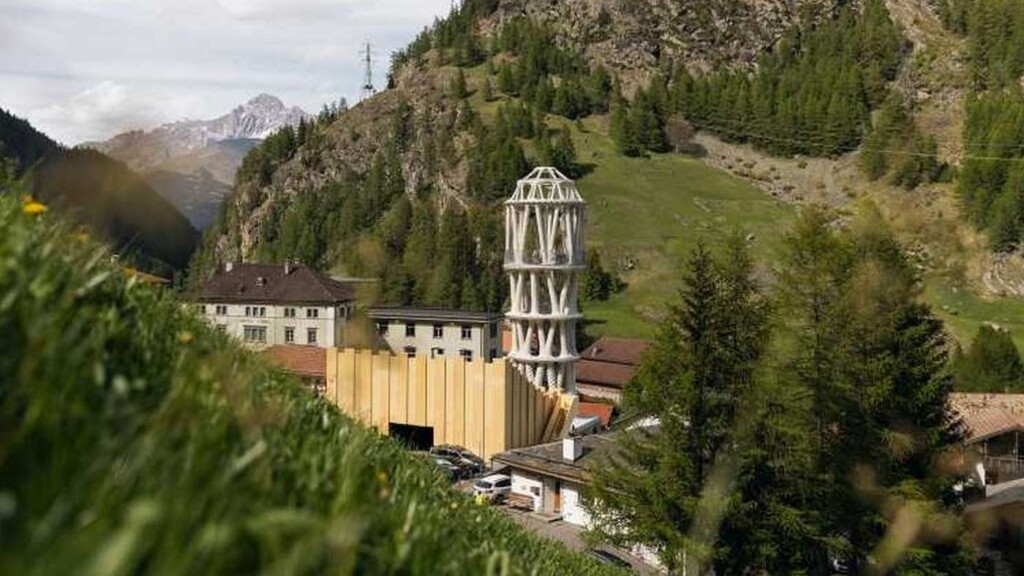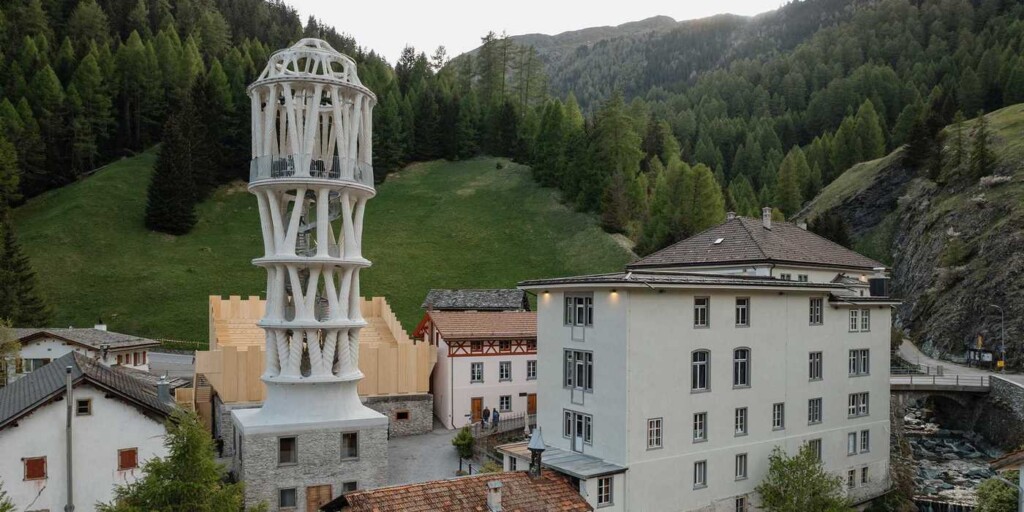 The village of Mulegns with the White Tower – credit, Benjamin Hofer Nova Fundaziun Origen
The village of Mulegns with the White Tower – credit, Benjamin Hofer Nova Fundaziun OrigenIn the usually sleepy Swiss town of Mulegns, pop. 11, a dramatic white tower rises four stories into the Alpine air—the tallest 3D-printed structure on earth.
One might imagine such a technological marvel to be debuted in a square in the Silicon Valley cities of San Jose or San Francisco, or perhaps, being that it was accomplished by the Swiss, to garnish the slopes of Davos where millionaires gather to chin wag about the future of the world.
Instead, visitors came to Mulegns from all over Switzerland and further afield to see the ‘Tor Alva’ or white tower, for themselves. A tarp covering was removed by helicopter on the eve of the opening, revealing the delicate structure which now blends into the mountain landscape of the Julier Pass.
It’s an architectural landmark, a pioneering work of digital fabrication, and an instrument in the revival of Mulegns, a mountain village threatened by depopulation.
The Origen cultural foundation led the work in collaboration with ETH Zurich—Europe’s finest technical university, to celebrate culture and the arts and to give the village a new lease of life. Starting tomorrow, the Tor Alva will be open daily for guided tours. From July onwards, the space will also host staged performances, as it is intended to remain in Mulegns for at least 5 years.
The form of the structure is reminiscent of an ornate layered cake—a reference to the emigration history of confectioners from Graubünden who exported their skills from here to the whole of Europe. Thirty-two sculptured white concrete columns rise up over four stories, becoming thinner and more branched, before fanning out in an almost tree-like fashion to form the domed space at the top.
The tower was designed by architect Michael Hansmeyer and ETH Professor of Digital Building Technologies Benjamin Dillenburger. Instead of relying on traditional concrete formwork, they opted for an additive manufacturing process, whereby an industrial robot applies the concrete layer by layer into free-form elements without any supportive casting molds. The design is based on complex algorithms that generate the ornamental and the structural aspects at the same time.
 The village of Mulegns with the White Tower – credit, Benjamin Hofer Nova Fundaziun Origen
The village of Mulegns with the White Tower – credit, Benjamin Hofer Nova Fundaziun OrigenTo make this process possible, a specially developed concrete was needed. It had to be soft enough to bond the delicate structures, while hardening quickly enough to support the subsequent layers without support molds. Robert Flatt, ETH Professor of Physical Chemistry of Building Materials, developed a novel mixture for this purpose. Just before the concrete leaves the pressurized nozzle, two additives are blended into the mixture, allowing the characteristic droplet-like relief on the columns to be achieved.
“The tower combines the latest insights from research with the expertise of companies and experts. Building the tower here, at the foot of the Julier Pass, has also allowed our researchers to gain important practical experience,” said President of ETH Zurich Joël Mesot.
THE BEST OF SWITZERLAND: From Sewage-Filled Waters to Crystal Blue: Switzerland Rivers and Lakes Offer Hope for Cleaning Up Other Countries
What is special about this project is that the 3D-printed elements not only serve as a shell, but for the first time they are also load-bearing. Until now, a suitable method to reinforce 3D-printed concrete effectively has been lacking. This is now possible thanks to a newly developed reinforcement concept implemented using a robot-assisted innovation.
While one robot applies the concrete in layers, a second places a ring-shaped reinforcement in the new structure every few inches. These are supplemented by longitudinal rebars that are added after printing. The process, known as “reinforcement that grows” was developed by ETH professors Walter Kaufmann, Robert Flatt and Benjamin Dillenburger.
3D-PRINTING BREAKTHROUGHS: Holographic 3D Printing Has the Potential to Revolutionize Multiple Industries, Researchers Demonstrate
In addition, the researchers developed a new testing method which allows the load-bearing capacity of 3D-printed concrete to be reliably calculated for the first time. This is a key requirement to ensure that such buildings can in the future be tested just as safely as conventional reinforced concrete structures.
It took five months to print the columns, and the components were then assembled in and delivered to Mulegns via the Julier road.
SHARE This Monumental Achievement With Your Friends…
Source link

